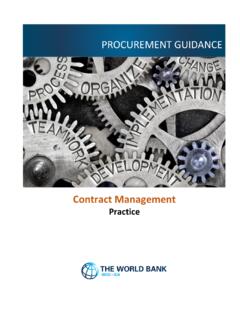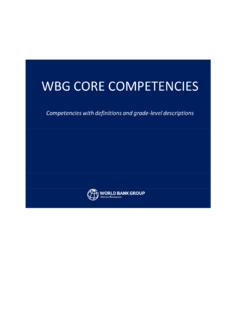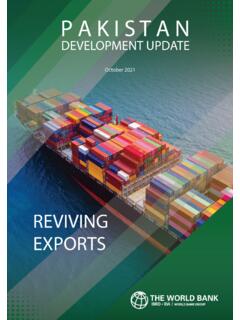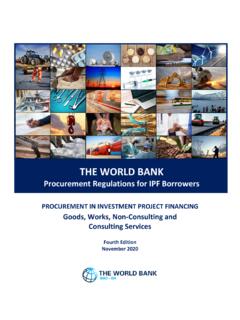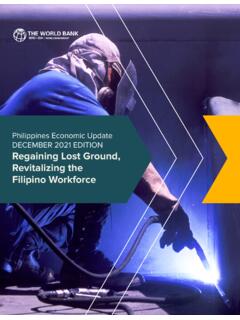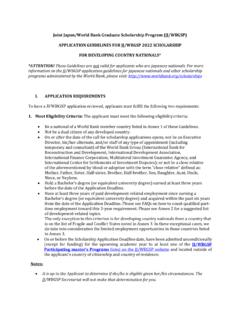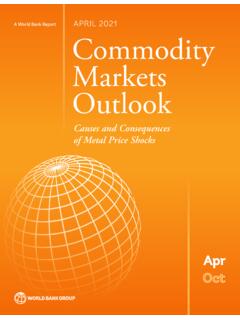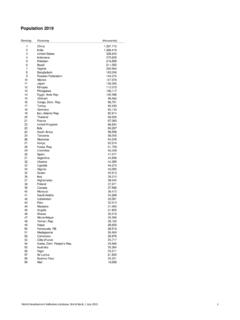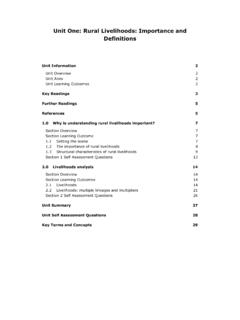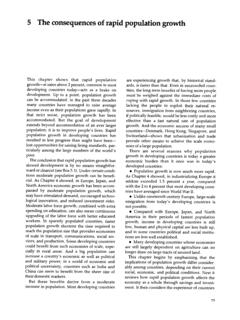Transcription of Global Economic Prospects: Sub-Saharan Africa January 2022
1 Global Economic Prospects: Sub-Saharan Africa January 2022. Recent developments: Output in Sub-Saharan Africa (SSA) grew by an estimated percent in 2021, driven by a rebound in commodity prices and an easing of social restrictions. However, the recovery remains fragile and insufficient to reverse a pandemic-induced increase in poverty and the threat of recurrent COVID-19 outbreaks lingers. The Omicron variant is now contributing to a surge in new cases across the region. More than 70 percent of SSA countries reported at least a 50 percent increase in new COVID-19 cases during the last two weeks of 2021. The services, tourism, and manufacturing sectors have been adversely affected by the pandemic, while sustained losses to incomes and employment, and elevated inflation have held back a recovery in consumer spending.
2 Increasing social unrest, insecurity, and civil conflicts, especially in the Sahel region (Burkina Faso, Chad, northeastern Nigeria, Niger, Mali, and Mauritania) and Ethiopia, restrained investment spending. Policy space to support recoveries has narrowed further across the region owing to increasing public debt levels and lost fiscal revenue. Growth in the three largest SSA economies Angola, Nigeria, and South Africa was an estimated percent in 2021, an upward revision from previous estimates. In Angola and Nigeria, growth was driven by the recovery in non-oil sectors; oil production across the region remained below pre-pandemic levels because of disruptions in maintenance work and declining investment in extractive industries.
3 In South Africa , a strong rebound earlier in the year was disrupted by severe COVID-19 outbreaks, social unrest, and power shortages. Elsewhere in the region, growth in non-oil commodity exporters was supported by surging prices of metals and food commodities; meanwhile, disruptions to international travel and tourism continued to weigh on recoveries in tourism-reliant countries (Namibia, Seychelles). Outlook: Growth in SSA is projected to firm slightly during the forecast horizon, to percent in 2022 and percent in 2023. This outlook is nearly a full percentage point below the 2000-19 average, however, reflecting the continued effects of the pandemic, reduced policy support, and policy uncertainty and worsening security situation in some countries.
4 Elevated commodity prices are expected to support near-term recovery across the region, with higher oil prices and the gradual easing of OPEC+ production cuts benefiting Nigeria and Angola. Growth in Nigeria is expected to reach percent in 2022 and percent in 2023, while Angola's economy is projected to grow by 3 percent on average in 2022-23. Growth in South Africa is forecast to moderate to its pre-pandemic trend, being held back by structural impediments and elevated levels of public debt. High prices for food commodities like coffee and cotton will benefit agricultural exporters (Ethiopia, Kenya, and Tanzania). However, for some countries, expansion of agricultural activities will be constrained by a variety of uncertainties, including droughts and lower than average rainfall as well as intensifying conflict.
5 The pandemic has set back progress on poverty reduction and key development goals across the region, reversing more than a decade of gains in per capita income in some countries. In over a third of the region's economies, including Angola, Nigeria, and South Africa , per capita incomes are projected to remain lower in 2022 than a decade ago. Risks: Risks to the outlook are tilted to the downside. Poverty, food insecurity, rising food prices, and geopolitical tensions could dampen consumer sentiment and hinder growth. A substantial moderation of the Global Economic growth could trigger a significant downward correction in commodity prices to the detriment of the region's oil and metals producers.
6 Countries facing debt sustainability challenges may face reduced access to external funding, forcing abrupt fiscal adjustment. Very low COVID-19 vaccination rates in the region pose a threat of renewed and more severe outbreaks, which could trigger recurrent disruption to activity. A prolonged pandemic could amplify past development and health challenges, derail structural and fiscal reforms, and result in lasting human capital losses. Download Global Economic Prospects Sub-Saharan Africa Country Forecasts (Annual percent change unless indicated otherwise). 2019 2020 2021e 2022f 2023f GDP at market prices (average 2010-19 US$). Angola Benin Botswana Burkina Faso Burundi Central African Republic Cabo Verde Cameroon Chad Comoros Congo, Dem.
7 Rep. Congo, Rep. C te d'Ivoire Equatorial Guinea Eritrea Eswatini Ethiopia a Gabon Gambia, The Ghana Guinea Guinea-Bissau Kenya Lesotho Liberia Madagascar Malawi Mali Mauritania Mauritius Mozambique Namibia Niger Nigeria Rwanda S o Tom and Pr ncipe Senegal Seychelles Sierra Leone South Africa Sudan South Sudan a Tanzania Togo b Uganda a Zambia Zimbabwe Source: World Bank. Note: e = estimate; f = forecast. World Bank forecasts are frequently updated based on new information and changing ( Global ) circumstances. Consequently, projections presented here may differ from those contained in other Bank documents, even if basic assessments of countries' prospects do not significantly differ at any given moment in time.
8 A. Fiscal-year based numbers. b. For Togo, growth figure in 2019 is based on pre-2020 rebasing GDP estimates.

